Rattlesnake Formation
The Rattlesnake Formation is a Miocene to late Pliocene geologic formation found along the John Day River Valley of Oregon, in the Western United States.
| Rattlesnake Formation Stratigraphic range: Miocene-Late Pliocene | |
|---|---|
 The caprock in this photo (near Picture Gorge) is the ignimbrite layer | |
| Type | Sedimentary and igneous |
| Overlies | Mascall Formation, Columbia River Basalt Group |
| Area | John Day Valley |
| Thickness | 700 feet (210 m) |
| Lithology | |
| Primary | Fanglomerate, siltstone |
| Other | Tuff (ignimbrite) |
| Location | |
| Coordinates | 44.5°N 119.6°W |
| Approximate paleocoordinates | 44.5°N 116.9°W |
| Region | Oregon |
| Country | |
| Extent | eastern Oregon |
| Type section | |
| Named for | Rattlesnake Creek |
| Named by | J. C. Merriam |
| Year defined | 1901[1] |
 Rattlesnake Formation (the United States)  Rattlesnake Formation (Oregon) | |
Description
The formation is described in Geologic Formations of Eastern Oregon (1972) as follows:
The unit is composed of up to 700 feet of fanglomerate and finer terrestrial sediments and a 40-foot thick ignimbrite unit which crops out in the middle of the section. The gravel is well rounded and consists of pebbles of basalt, chert, siltstone, diorite, rhyolite, and chert set in a medium-grained matrix of poorly indurated volcanic sandstone. The ignimbrite displays zonation typical of welded ashflow tuffs and is a prominent ridge former.[2]
Age
The ignimbrite was radiometrically dated by the Potassium–argon method at 6.4 million years by Evernden and James (1964).[3]
Fossil content
Middle and late Pliocene mammals have been recovered from beneath the ignimbrite. Fossils include ambeledon (four tusked elephants), Mylohyus(peccary), teleoceras(north american rhino), Indarctos (bear), pliohippus (a horse) and possibly Machairodus (a saber-tooth cat).
In the lower fanglomerate member of the Rattlesnake Formation, remains of Pekania occulta were found.[4][5]
References
- Merriam, J. C., 1901. A contribution to the geology of the John Day Basin, Oregon: Univ. Calif., Dept. Geol. Sci. Bull., v. 2, p. 269-314
- Geologic Formations of Eastern Oregon (East of longitude 121°30'), 1972. John D. Beaulieu. Bulletin 73. Oregon Department of Geology and Mineral Industries.
- Evernden, J. F., and James, G. T., 1964. Potassium-argon dates of the Tertiary floras of North America: Am. Jour. Sci., v. 262, p. 945-974.
- Samuels & Cavin, 2013
- Pekania occulta type locality at Fossilworks.org
Bibliography
- Samuels, J. X., and J. Cavin. 2013. The Earliest Known Fisher (Mustelidae), a New Species From the Rattlesnake Formation of Oregon. Journal of Vertebrate Paleontology 33. 448–454.